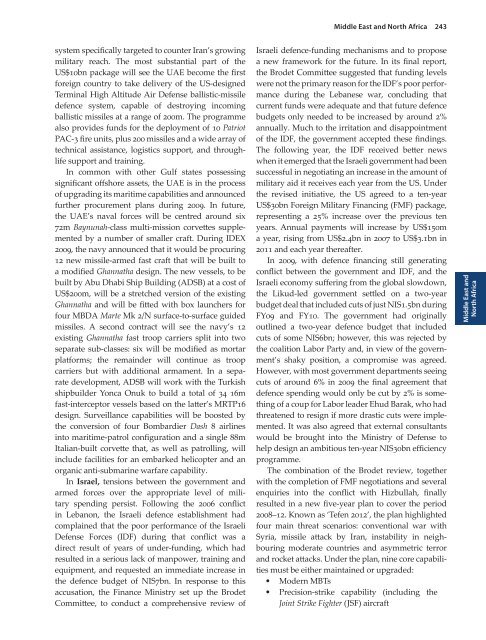You also want an ePaper? Increase the reach of your titles
YUMPU automatically turns print PDFs into web optimized ePapers that Google loves.
system specifically targeted to counter Iran’s growing<br />
military reach. The most substantial part of the<br />
US$10bn package will see the UAE become the first<br />
foreign country to take delivery of the US-designed<br />
Terminal High Altitude Air Defense ballistic-missile<br />
defence system, capable of destroying incoming<br />
ballistic missiles at a range of 200m. The programme<br />
also provides funds for the deployment of 10 Patriot<br />
PAC-3 fire units, plus 200 missiles and a wide array of<br />
technical assistance, logistics support, and throughlife<br />
support and training.<br />
In common with other Gulf states possessing<br />
significant offshore assets, the UAE is in the process<br />
of upgrading its maritime capabilities and announced<br />
further procurement plans during 2009. In future,<br />
the UAE’s naval forces will be centred around six<br />
72m Baynunah-class multi-mission corvettes supplemented<br />
by a number of smaller craft. During IDEX<br />
2009, the navy announced that it would be procuring<br />
12 new missile-armed fast craft that will be built to<br />
a modified Ghannatha design. The new vessels, to be<br />
built by Abu Dhabi Ship Building (ADSB) at a cost of<br />
US$200m, will be a stretched version of the existing<br />
Ghannatha and will be fitted with box launchers for<br />
four MBDA Marte Mk 2/N surface-to-surface guided<br />
missiles. A second contract will see the navy’s 12<br />
existing Ghannatha fast troop carriers split into two<br />
separate sub-classes: six will be modified as mortar<br />
platforms; the remainder will continue as troop<br />
carriers but with additional armament. In a separate<br />
development, ADSB will work with the Turkish<br />
shipbuilder Yonca Onuk to build a total of 34 16m<br />
fast-interceptor vessels based on the latter’s MRTP16<br />
design. Surveillance capabilities will be boosted by<br />
the conversion of four Bombardier Dash 8 airlines<br />
into maritime-patrol configuration and a single 88m<br />
Italian-built corvette that, as well as patrolling, will<br />
include facilities for an embarked helicopter and an<br />
organic anti-submarine warfare capability.<br />
In Israel, tensions between the government and<br />
armed forces over the appropriate level of military<br />
spending persist. Following the 2006 conflict<br />
in Lebanon, the Israeli defence establishment had<br />
complained that the poor performance of the Israeli<br />
Defense Forces (IDF) during that conflict was a<br />
direct result of years of under-funding, which had<br />
resulted in a serious lack of manpower, training and<br />
equipment, and requested an immediate increase in<br />
the defence budget of NIS7bn. In response to this<br />
accusation, the Finance Ministry set up the Brodet<br />
Committee, to conduct a comprehensive review of<br />
Middle East and North Africa<br />
243<br />
Israeli defence-funding mechanisms and to propose<br />
a new framework for the future. In its final report,<br />
the Brodet Committee suggested that funding levels<br />
were not the primary reason for the IDF’s poor performance<br />
during the Lebanese war, concluding that<br />
current funds were adequate and that future defence<br />
budgets only needed to be increased by around 2%<br />
annually. Much to the irritation and disappointment<br />
of the IDF, the government accepted these findings.<br />
The following year, the IDF received better news<br />
when it emerged that the Israeli government had been<br />
successful in negotiating an increase in the amount of<br />
military aid it receives each year from the US. Under<br />
the revised initiative, the US agreed to a ten-year<br />
US$30bn Foreign Military Financing (FMF) package,<br />
representing a 25% increase over the previous ten<br />
years. Annual payments will increase by US$150m<br />
a year, rising from US$2.4bn in 2007 to US$3.1bn in<br />
2011 and each year thereafter.<br />
In 2009, with defence financing still generating<br />
conflict between the government and IDF, and the<br />
Israeli economy suffering from the global slowdown,<br />
the Likud-led government settled on a two-year<br />
budget deal that included cuts of just NIS1.5bn during<br />
FY09 and FY10. The government had originally<br />
outlined a two-year defence budget that included<br />
cuts of some NIS6bn; however, this was rejected by<br />
the coalition Labor Party and, in view of the government’s<br />
shaky position, a compromise was agreed.<br />
However, with most government departments seeing<br />
cuts of around 6% in 2009 the final agreement that<br />
defence spending would only be cut by 2% is something<br />
of a coup for Labor leader Ehud Barak, who had<br />
threatened to resign if more drastic cuts were implemented.<br />
It was also agreed that external consultants<br />
would be brought into the Ministry of Defense to<br />
help design an ambitious ten-year NIS30bn efficiency<br />
programme.<br />
The combination of the Brodet review, together<br />
with the completion of FMF negotiations and several<br />
enquiries into the conflict with Hizbullah, finally<br />
resulted in a new five-year plan to cover the period<br />
2008–12. Known as ‘Tefen 2012’, the plan highlighted<br />
four main threat scenarios: conventional war with<br />
Syria, missile attack by Iran, instability in neighbouring<br />
moderate countries and asymmetric terror<br />
and rocket attacks. Under the plan, nine core capabilities<br />
must be either maintained or upgraded:<br />
• Modern MBTs<br />
• Precision-strike capability (including the<br />
Joint Strike Fighter (JSF) aircraft<br />
Middle East and<br />
North Africa


